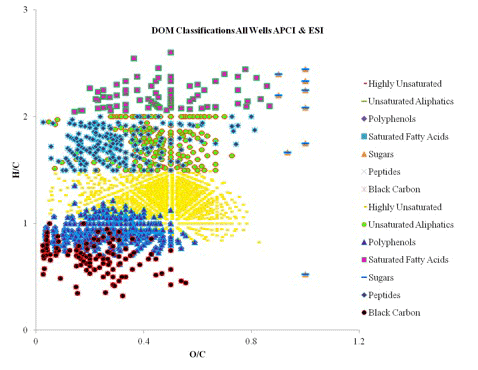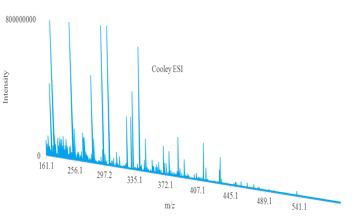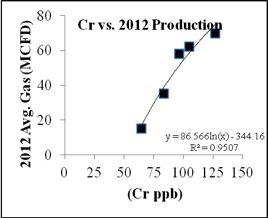58th Annual Report on Research 2013 Under Sponsorship of the ACS Petroleum Research Fund
Reports: DNI250999-DNI2: The Control of Dissolved Organic Matter Compositions on the Production of Biogenic Methane in Unconventional Gas Reservoirs
Michael Formolo, University of Tulsa
Overview
Dissolved organic matter (DOM) is one of the most complex carbon pools on Earth. The molecular characteristics of DOM are unresolved in unconventional shale gas reserves. The growing economic and societal importance of shale gas necessitates a better understanding of the subsurface geochemical processes driving biogenic gas formation. Our study area, the Devonian Antrim Shale Formation in the Michigan Basin, is one of the most economically important shale gas reservoirs in North America. The two main goals of this research was to address how the inorganic geochemical evolution of a unconventional gas reservoir and how the in-situ dissolved organic matter may be related to biogenic gas production. This was attempted using historical inorganic geochemical data integrated into GIS models and a state of the art FT-ICR-MS approach.
Results and Preliminary Interpretations
Dissolved Organic Matter
Over the last two years our results have demonstrated that variable concentrations of dissolved organic matter and compositional differences exist in the Antrim shale. These differences are seen in DOM pools between wells with high gas production and low gas production. The inorganic geochemical evidence also shows statistical correlations between many trace metals and gas production.
Compositional variations, measured using FT-ICR-MS, are illustrated in the Figure 1. These data represent all the wells sampled in the Antrim formation. A wide range of dissolved organic matter compositions were determined, ranging from inert black carbon to bioavailable sugars. When grouped together the variations in the wells is unclear, however, individual FT-ICR-MS results for the highest and lowest gas production wells are shown in Figures 2 and 3.
Compositional differences are seen in DOM pools between wells with high gas production (Figure 2) and low gas production (Figures 3). For example, highly-unsaturated organic compounds are elevated in lower producing wells. There is also a strong linear correlation between the number of saturated organic compounds present in formation water and gas production. The high gas producing well tends to have elevated polyphenolic compounds. The presence and distribution of these compounds also illustrate the variety of geochemical reactions governing the presence of these compounds, including hydrogenation, dehydrogenation, methylation, demethylation, hydration and condensation. Further work is needed to integrate these into a biochemical model of biogenic gas production in the susbsurface.

Figure 1: Dissolved Organic Carbon (DOC) sampled for all five wells in this study.

Figure 2: FT-ICR-MS results m/z versus peak intensity for the highest gas producing well sampled.

Figure 3: m/z versus peak intensity for the lowest gas producing well sampled.
There are multiple reasons that may explain why the DOM pools among the wells differ. The variability could be from variations in kerogen, possibly due to biodegradation in these kerogens as demonstrated by Formolo et al. (2008). Other possibilities include the source for the DOM (Dittmar and Koch, 2006). Or, perhaps the microbial community cannot utilize the highly-unsaturated compounds. However, since this study attempted to extract and measure DOM from an environment where little to no work was previously done, some of the differences could be due to sampling and analytical procedures. Though the results are encouraging in that they appear to be consistent with expectations and showing true natural variability. This present work is among the first attempts to measure DOM for FT-ICR-MS analysis in deep subsurface shales and over time the sampling and analytical approaches will be refined to become more efficient and accurate. Given these limitations, this work still successfully sampled and analyzed DOM from an unexplored pool and has resulted in laying the foundation for future research in deep subsurface reservoirs.
Inorganic Geochemistry
Additionally, gas production is statistically correlated with trace elements (TE) concentrations, specifically Mg, Ca, Mn, Sr, V, Cr, Fe, As and Ba. This research sheds light into the effects of long-term natural gas production in biogenic reservoirs and may offer a new tool for predicting production potential. However, what remains unknown is if these relationships are due to production or in-fact is related to microbial activity in the subsurface. Figure 4 demonstrates an example of the statistically significant correlation seen for a select trace metal and gas production.

Figure 4: Chromium (Cr) ppb and 2012 average gas production (MCFD)
The inorganic geochemical results highlight there is a strong positive correlation between many trace elements in the formation water and gas production. At present, it is unclear if this is the result of production or is evidence of a relationship between bioessential trace nutrients and biogenic gas production. Further work is warranted.
Conclusions
The preliminary results and interpretations from this study have demonstrateed that biogenic gas producing wells in the Antrim formation do have dissolved organic matter present and there are compositional differences. The main compositional variation between producing and non-producing wells is the enrichment of highly-unsaturated and polyphenolic compounds in the lower gas producing wells. A secondary observation is that there is a strong correlation between saturated saturated fatty acids and gas production averages. Also, results demonstrate a correlation between trace metal concentration and biogenic gas production.
Broader Impacts
The funding for this work has been instrumental in supporting an early career scientist and graduate student. The graduate student presented the research at two meetings, the AAPG Rocky Mountain Rendevous and the International Petroleum Environmental Conference (IPEC). The funding also provided financial support for the graduate student to dedicate the necessary time and effort needed to develop a new sampling methodology for this work and for the analytical work. These efforts were the critical first step to create a framework for future work in the characterizing the dissolved organic matter associated with biogenic gas reservoirs. In addition, the work produced by the graduate student generated interest from multiple Ph.D. programs and industry leaders. Because of the expertise developed during this project the student received a job offer and is currently employed by Newfield Energy in Tulsa, OK. These opportunities were not possible without the generous support from the donors of the American Chemical Society Petroleum Research Fund.




Copyright © 2014 American Chemical Society











